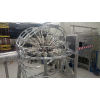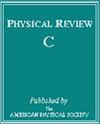天然碳上中子弹性散射的角度分布测量
IF 3.4
2区 物理与天体物理
Q1 Physics and Astronomy
引用次数: 0
摘要
在 1 至 8 MeV 的快中子能量区研究了天然碳上中子弹性散射的角度分布。实验在盖尔电子直线加速器(GELINA)设施的白中子源上进行,使用的天然碳样品有薄有厚。这项工作证明了使用薄样品以避免强烈的多重散射效应的必要性。利用弹性和非弹性散射阵列(ELISA)检测了散射产生的中子和γ射线,该阵列由 32 个液态有机闪烁体组成。n-γ 的分离是通过脉冲形状分析实现的。对每种样品都研究了不同的方法,一种是基于全局响应函数模型,另一种是基于每个探测器模型。探测器被放置在相对于中子束方向介于 16∘ 和 164∘ 之间的八个不同探测角上,这样就可以通过实施高斯-勒格正交法则同时计算微分截面和积分截面。中子通量是用 U235 电离室测量的。提取了相对于 U235(n,f)截面的角度分布。结果与 EXFOR 库中的其他实验数据以及最新的核数据评估进行了比较。角度积分截面与核数据评估结果非常吻合,就角度分布而言,ENDF/B-VIII.0 在所有八个探测角度都更好地再现了实验数据。本文章由计算机程序翻译,如有差异,请以英文原文为准。

Angular distribution measurements of neutron elastic scattering on natural carbon
The angular distributions of neutron elastic scattering on natural carbon were studied in the fast neutron energy region between 1 and 8 MeV. The experiments were carried out at the white neutron source of the Geel Electron Linear Accelerator (GELINA) facility by using thin and thick natural carbon samples. This work demonstrates the need for using thin samples to avoid strong multiple scattering effects. Neutrons and rays from scattering were detected using the ELastic and Inelastic Scattering Array (ELISA), a setup consisting of 32 liquid organic scintillators. The separation was achieved via pulse-shape analysis. For each sample a different approach in methodology is studied, one based on a global response function model and another one based on a per-detector model. The detectors are placed at eight different detection angles between and with respect to the neutron beam direction, allowing the simultaneous calculation of both the differential and the integral cross section by implementing the Gauss-Legendre quadrature rule. The neutron flux was measured with a ionization chamber. The angular distributions were extracted relative to the cross section. The results are compared with other experimental data available in the EXFOR library, along with the most recent nuclear data evaluations. The angle-integrated cross sections are in excellent agreement with the nuclear data evaluations and for the angular distributions, ENDF/B-VIII.0 is better reproducing the experimental data in all eight detection angles.
求助全文
通过发布文献求助,成功后即可免费获取论文全文。
去求助
来源期刊

Physical Review C
物理-物理:核物理
CiteScore
5.70
自引率
35.50%
发文量
0
审稿时长
1-2 weeks
期刊介绍:
Physical Review C (PRC) is a leading journal in theoretical and experimental nuclear physics, publishing more than two-thirds of the research literature in the field.
PRC covers experimental and theoretical results in all aspects of nuclear physics, including:
Nucleon-nucleon interaction, few-body systems
Nuclear structure
Nuclear reactions
Relativistic nuclear collisions
Hadronic physics and QCD
Electroweak interaction, symmetries
Nuclear astrophysics
 求助内容:
求助内容: 应助结果提醒方式:
应助结果提醒方式:


